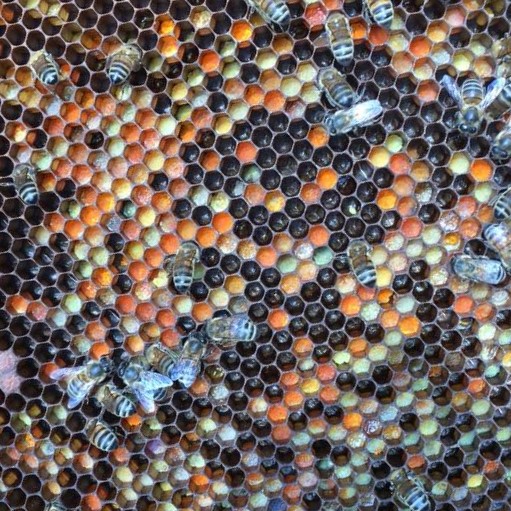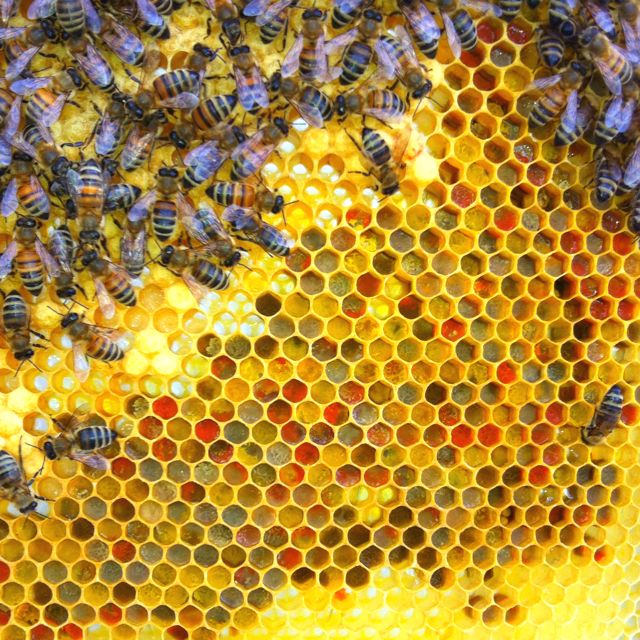The photo of the pollen below is quite stunning. Can you see how the colours vary greatly between the different cells? The honeycomb is actually black, almost. And that’s because it’s actually in the brood nest.
And you can see, if you look carefully, there are little white specks in the base of the empty cells where there are eggs that have been freshly laid. Then there’s the pollen; nearly every different shade under the sun. You can see yellow and orange, and potentially pale green.
See how bees store pollens gathered from different flowers are stored separately. Just like pollen in this photo honeybees store the nectar from different flowers and trees in different areas on the honey comb.
Why is the honey comb looking so colourful?
The bees have stored different pollens of different colours, which means they’ve stored pollens from different flowers in their own cells. So pollen from dandelion would be in one cell, and pollen from sunflower would be in another. Pollen from a blue flower with a pale blue pollen would be in a different cell. And the honey bees are grouping the same colours, or types of pollen, together.
It’s a bit like your larder cupboard at home, where you’ve got tins and packets of non perishables scattered all over the place. Sometimes you have four cans of baked beans in one place, and you will see four cells of the same shade of orange all next to each other. So they potentially came from the same species of flower.
Separating and grouping different pollens
So the honey bees separate the different pollens, and the different species, into different cells so they can treat it a bit like our larder cupboard. They can go and select a specific species of flower pollen for a specific reason; but we don’t actually understand why they bother to do this. They obviously take great care over it, and separate things in a very particular way.
A very similar thing happens in the nest with honey, or nectar, from different flowers. Bees will typically put nectar from lime trees in one bank of honeycomb cells, and honey from oilseed rape in a different area. And you can see this when you shine a strong light through the comb from the back to the front with the honeycomb being illuminated. Remarkable to see the different shades of honey.
Different shades and flavours of honey
When beekeepers spin the honey out in the extractor, unfortunately all the different shades of honey gets mixed up. All that time and effort the honey bees spent segregating the pollen is lost, and you end up with a mishmash of a multi floral honey to eat.
Sometimes honey is sold as a specific type of honey, like clover honey, or heather honey, or lime honey. And that’s when you get such a vast amount of honey in a number of frames that you can say 90% of the honey, or 95% of the honey, that you’re spinning out is heather honey; you can then call it heather honey on the label. But there’s always a percentage of other honey mixed in with it. It’s never 100% pure.
But why the separation of pollen in the comb?
We don’t know. The honey bees have clearly separated the pollen that you’re looking at in the picture for a very particular reason, and we are none the wiser. But there’s obviously a process in there somewhere.
Imagine deep purple or crimson red honey
The maze of colours in this comb is an image few people get to see. And the location of a nest can have a wonderful effect on the colours that appear. When I used to keep bees near to a zoo, where they had tropical greenhouses for the birds and butterflies, the bees used to go in and forage on the foreign plants and you’d get the occasional honey cells that were crimson red, or deep purple.
Imagine having a deep purple honey or a crimson red honey. Well, there wasn’t enough of the colours in the comb to make a jar of honey that’s either crimson, or purple, or red, or yellow. Most of the honey came out the usual colour that you see on a shelf. But the actual honeycomb that was in the hive when held up to the light was fascinating in the way that the different nectars were separated.

